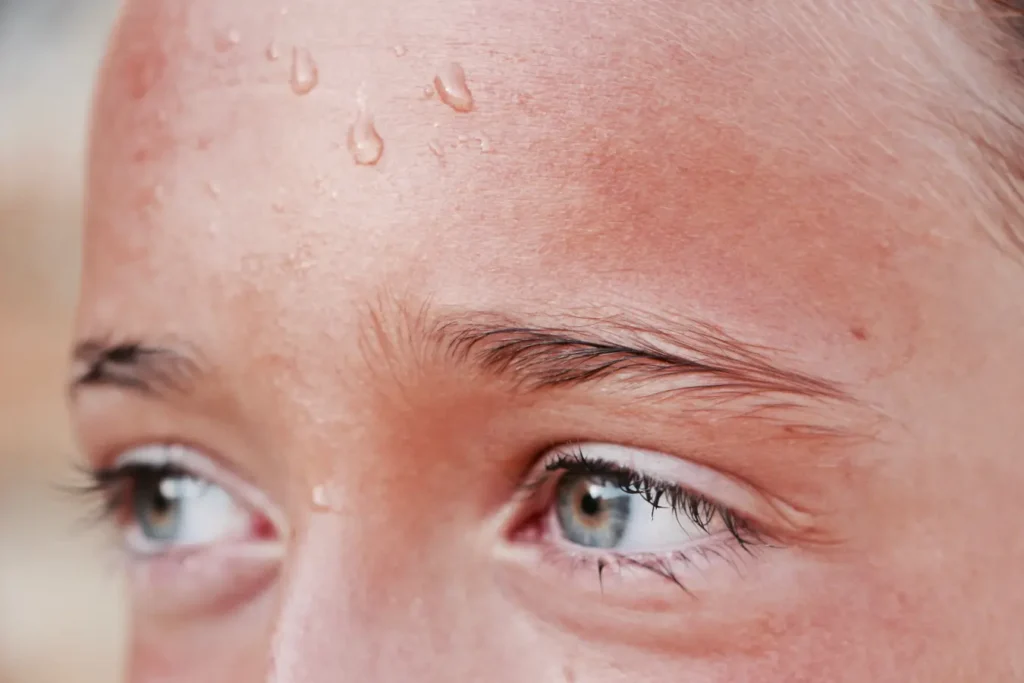When it is hot or when we exercise, we sweat to regulate our body temperature. Sweat, expelled by the sweat glands, is deposited on the skin and, when it evaporates, cools us down.
Although sweat can occur on any surface of the skin, it most commonly occurs in the armpits, face, palms of the hands, and soles of the feet. We also sweat in response to emotional stimuli.
Sweating is not bad
Sweat generally does not smell of anything, “except for that produced in the armpits and pubic area, where special sweat glands are located that, with sweat, secrete a series of fatty acids and proteins that are fermented by the action of bacteria on the skin,” explains Sanitas, a health insurance company specializing in health.
“By the way, sweaty feet don’t smell either. In this case, the smell is due to the accumulation and fermentation of residues in the shoes, since they are not changed regularly,” the company adds.
“Sweating is not bad, it is important for controlling our temperature and creating a first barrier of skin defense,” emphasize specialists from the Spanish Academy of Dermatology and Venereology (AEDV).
“However, some people produce more sweat than necessary for these purposes, which is known as hyperhidrosis or hyperhidrosis,” AEDV adds.
This excessive sweating can affect the entire body, which is called generalized hyperhidrosis, or it can affect specific areas of the body, in which case it is called focal hyperhidrosis.
Furthermore, hyperhidrosis can be primary, the cause of which is unknown, or secondary, when it is due to some disease or the taking of certain medications.
“Hyperhidrosis itself is not serious, although it does significantly affect the quality of life of those who suffer from it. In this sense, there are different treatments to combat it, depending on its intensity and the affected area,” say the dermatologists at AEDV.
“For mild and moderate forms of hyperhidrosis, antiperspirants are very useful. These substances are applied directly to the skin to reduce sweating.” Dermatologists from the Quirón Salud hospital group recommend using them at night and on dry skin, and when there is an improvement, reducing their use to two or three times a week.
“The main adverse effect of these products is that they can irritate the skin,” these specialists indicate.
Another option is anticholinergic drugs. “Sweating is caused by the release of a substance called acetylcholine and anticholinergic drugs act on it,” explains Quirón Salud.
“Some of these drugs are applied directly to the skin, while others must be taken orally. The latter are used in cases of generalized excessive sweating,” they add.
Some solutions for excessive sweating
Hyperhidrosis is also treated by iontophoresis, a technique that requires a specific device but can be performed at home. It is especially indicated for excessive sweating of the palms of the hands and soles of the feet, they say.
“It consists of placing the hands or feet in trays filled with liquid. There are two methods: running water or water to which an anticholinergic solution is added. With the help of electrodes, an electric current is generated in the submerged areas that act on the sweat glands. In the case of the armpits, the mechanism is similar except that moistened sponges are used,” describe dermatologists Carlos Hernández and Javier del Boz.
The doctors explain that there are two types of iontophoresis depending on the characteristics of the current used. “Thus, devices with direct current are more recommended for the feet, since their application can be very painful in the hands and armpits. On the other hand, those with pulsed current are more indicated for hands and armpits, as well as for children, since their use causes less discomfort,” affirm Hernández and Del Boz.
Another therapeutic option for hyperhidrosis is botulinum toxin, widely used to combat excessive sweating of the armpits.
“In the case of palmoplantar and axillary hyperhidrosis, an effective treatment is botulinum toxin. Using very fine needles, the toxin is introduced into the skin, which produces a blocking effect on the sweat glands and reduces sweat production,” say the specialists at the Arques Clinic aesthetic clinic in Marbella (southern Spain).
This procedure results in the cessation of sweat production for approximately four to six months, so it must be repeated from time to time.
If the above treatments have not worked, surgery is an option. “Transthoracic sympathectomy is a treatment that consists of removing the lymph nodes responsible for stimulating sweating in the armpits and hands. It is performed by thoracic surgeons with excellent results in terms of reducing sweating in the hands and armpits, which is also permanent,” explains the AEDV.
“Its main drawback is the appearance of compensatory hyperhidrosis, that is, the patient stops sweating in the hands and armpits but may experience increased sweating in other areas such as the face, back, chest, etc.,” the Academy adds.
Another technique to combat hyperhidrosis is laser, which eliminates sweat glands by heating.
There are several types of lasers. One of them is Miradry, which is approved by the U.S. Food and Drug Administration (FDA).
“It is a device that, through a laser that emits electromagnetic energy, reaches the deepest layers of the skin and selectively destroys the sweat glands, thereby immediately eliminating problems of sweating and axillary odor,” say specialists from the Aesthetic Medicine Unit of the Quirón Salud Hospital in Valencia (eastern Spain).
“This treatment is not painful, as it is performed under local anesthesia, the session lasts about an hour and a half and recovery is very fast,” they add.
All of these treatments can put a stop to excessive sweating, a problem that, although not serious, can greatly disrupt the daily life of those who suffer from it.

